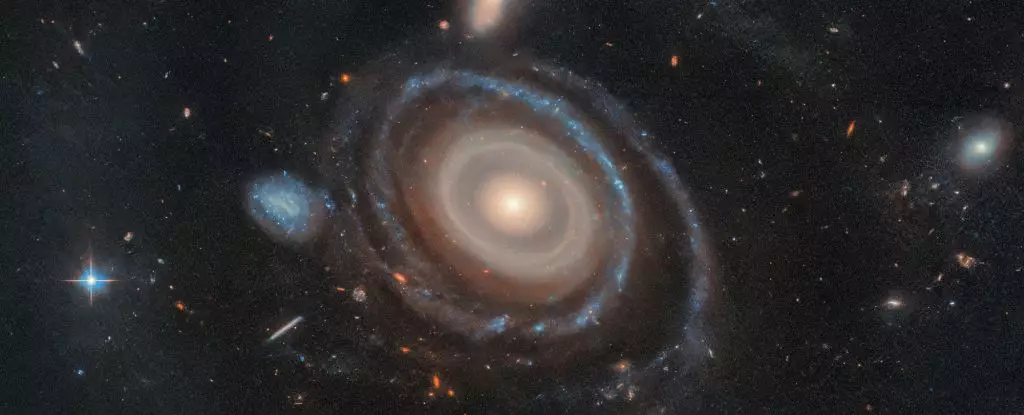In the vast expanse of the universe, galaxies, much like unique snowflakes, exhibit no two alike. However, a recent astronomical discovery offers a breathtaking exception: a galaxy sitting 567 million light-years from Earth, adorned with a stunning array of nine concentric rings. This galaxy has been aptly named the Bullseye Galaxy (LEDA 1313424), and its discovery reveals a fascinating interplay of cosmic interactions and cataclysmic events that reshape our understanding of galaxy formation and collisions. Researchers are eager to dive deeper into the mysteries that ring galaxies present and what this particular seismically affected galaxy signifies about cosmic evolution.
Astrophysicists analyzing data from advanced telescopes identified the Bullseye Galaxy, attracting attention for its striking structure and the circumstances that led to its formation. This extraordinary galaxy has become a focal point in understanding the consequences of galactic collisions. “We are observing the Bullseye at a notably significant moment,” remarks Pieter van Dokkum of Yale University. The timing of the discovery proves crucial; it occurs shortly after a neighboring blue dwarf galaxy collided with it, making it an invaluable subject for understanding the dynamics of ring galaxies.
Ring galaxies are rare formations whose creation involves unique conditions, making the Bullseye Galaxy a priceless contribution to astronomical study. Space, typically perceived as a void, is alive with movement as galaxies are drawn along filaments of the cosmic web, inciting numerous interactions and collisions among them. The array of structures and formations that arise from such interactions is diverse, and the study of the Bullseye Galaxy reveals more about the processes behind these collisions.
The Bullseye Galaxy’s internal structure is a testimony to its tumultuous history. Observations from the Hubble Space Telescope confirmed the presence of a smaller companion galaxy located a mere 130,000 kilometers (about 80,000 miles) from the Bullseye. Utilizing the Keck Cosmic Web Imager (KCWI), researchers were able to witness the gas streams connecting the two galaxies, thereby solidifying the connection between them. Imad Pasha of Yale highlighted the uniqueness of their findings, acknowledging that observing the gas flowing between these galaxies is a pivotal insight into how they interact.
The impact of the companion galaxy has expedited the formation of the concentric rings within the Bullseye Galaxy. As the smaller galaxy penetrated the heart of the larger one, shockwaves reverberated outward, compressing galactic material and igniting star formation in concentrated regions. This phenomenon elucidates why the rings exhibit a bright luminosity; they are teeming with star activity, representing a dynamic environment forged through extraordinary cosmic events.
What makes the Bullseye Galaxy particularly compelling is the revelation it offers about the lifecycle of galaxies and their interactions. The distinct arrangement of the rings, as observed by KCWI, provides a visual blueprint that aligns with theoretical predictions of how such structures propagate. The layering resembles ripples on a pond, where the initial impacts create immediate disturbances, followed by further expansions. This clarity of structure within the Bullseye Galaxy invites astronomers to refine their models concerning the timeline and effects of galactic collisions.
Moreover, the research surrounding the Bullseye Galaxy is set to enrich our understanding of galactic dynamics. By observing how gas travels from one galaxy to another, scientists can gather insight into the mechanisms of gas exchange and star formation as a result of collision events. Such findings are anticipated to lead to revelations about galaxy morphology and evolution over cosmological time scales. Future telescopes will undoubtedly enhance our capabilities to explore and catalog more such formations across the old cosmos, revealing insights about the orderly chaos of the universe.
The serendipitous discovery of the Bullseye Galaxy marks a significant milestone in the ever-evolving field of astronomy. This rare formation serves not only as a cosmic wonder but also as an essential piece of the puzzle in understanding the complex nature of galactic interactions. Continued exploration and observation of the cosmos promise to unveil further instances of ring galaxies, each contributing their narrative to the interstellar tapestry we strive to comprehend. Thus, as we set our gaze toward the stars, the Bullseye Galaxy stands as a testament to the interconnectedness and unpredictable beauty of our universe.

